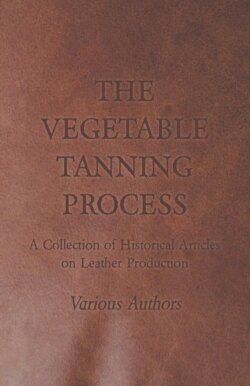Читать книгу The Vegetable Tanning Process - A Collection of Historical Articles on Leather Production - Various - Страница 4
На сайте Литреса книга снята с продажи.
ОглавлениеLeather Crafting
Leather is a durable and flexible material created by the tanning of animal rawhide and skin, often cattle hide. It can be produced through manufacturing processes ranging from cottage industry to heavy industry, and has formed a central part of the dress and useful accessories of many cultures around the world. Leather has played an important role in the development of civilisation from prehistoric times to the present, and people have used the skins of animals to satisfy fundamental (as well as not so essential!) needs such as clothing, shelter, carpets and even decorative attire. As a result of this importance, decorating leather has become a large past time. Leather crafting or simply leathercraft is the practice of making leather into craft objects or works of art, using shaping techniques, colouring techniques or both. Today, it is a global past time.
Some of the main techniques of leather crafting include:
Dyeing - which usually involves the use of spirit- or alcohol-based dyes where alcohol quickly gets absorbed into moistened leather, carrying the pigment deep into the surface. 'Hi-liters' and 'Antiquing' stains can be used to add more definition to patterns. These have pigments that will break away from the higher points of a tooled piece and so pooling in the background areas give nice contrasts. This leaves parts unstained and also provides a type of contrast.
Painting - This differs from leather dyeing, in that paint remains only on the surface whilst dyes are absorbed into the leather. Due to this difference, leather painting techniques are generally not used on items that can or must bend, nor on items that receive friction, such as belts and wallets - as under these conditions, the paint is likely to crack and flake off. However, latex paints can be used to paint flexible leather items. In the main though, a flat piece of leather, backed with a stiff board is ideal and common, though three-dimensional forms are possible so long as the painted surface remains secured. Unlike photographs, leather paintings are displayed without a glass cover, to prevent mould.
Stamping - Leather stamping involves the use of shaped implements (stamps) to create an imprint onto a leather surface, often by striking the stamps with a mallet. Commercial stamps are available in various designs, typically geometric or representative of animals. Most stamping is performed on vegetable tanned leather that has been dampened with water, as the water makes the leather softer and able to be compressed with the design. After the leather has been stamped, the design stays on the leather as it dries out, but it can fade if the leather becomes wet and is flexed. To make the impressions last longer, the leather is conditioned with oils and fats to make it waterproof and prevent the fibres from deforming.
Molding and shaping - Leather shaping or molding consists of soaking a piece of leather in hot or room temperature water to greatly increase pliability and then shaping it by hand or with the use of objects or even molds as forms. As the leather dries it stiffens and holds its shape. Carving and stamping may be done prior to molding. Dying however, must take place after molding, as the water soak will remove much of the colour. This mode of leather crafting has become incredibly popular among hobbyists whose crafts are related to fantasy, goth / steampunk culture and cosplay.
